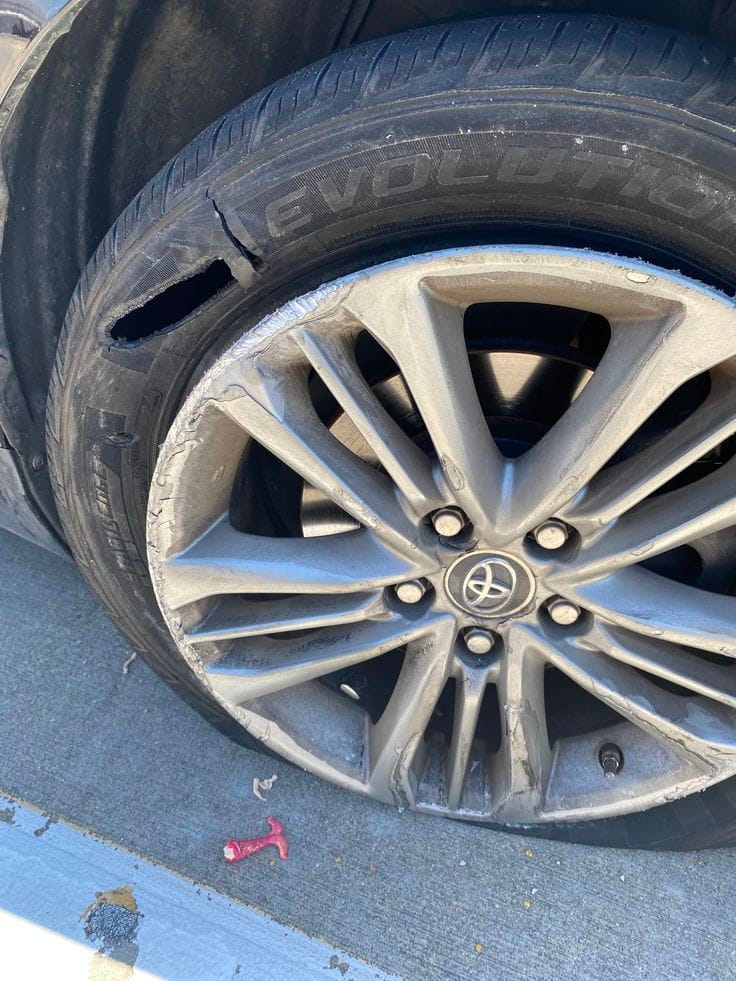What to Do If My Tyre Bursts While Driving: A Complete Safety Guide

Introduction
What to do if my tyre bursts while driving is a high-stress situation that requires quick thinking and proper technique to avoid accidents.
Whether you’re on a highway or a city road, knowing how to react can mean the difference between a safe stop and a dangerous crash.
This guide explains:
Why tyres burst (common causes and warning signs)
Step-by-step actions to take during a blowout
Mistakes to avoid that could worsen the situation
Prevention tips to reduce the risk of future incidents
If you’re in Nottingham and need urgent help, Mobile tyre fitting Nottingham services can provide fast, professional assistance.
Key Takeaways
Stay calm and grip the steering wheel firmly to maintain control.
Avoid sudden braking—ease off the accelerator and let the car slow naturally.
Pull over safely to the side of the road and turn on hazard lights.
Do not continue driving—a burst tyre can damage the wheel and suspension.
Prevent future blowouts by checking tyre pressure, tread depth, and overall condition regularly.
For immediate assistance, consider Mobile tyre fitting Nottingham services for on-the-spot repairs.
1. Why Do Tyres Burst While Driving?
Understanding the causes can help prevent future blowouts:
Underinflation
Low tyre pressure causes excessive flexing and heat buildup, leading to failure. Check pressure monthly—especially before long trips.
Overloading the Vehicle
Carrying too much weight strains tyres beyond their capacity. Always follow the manufacturer’s recommended load limit.
Punctures and Structural Damage
Hitting potholes, debris, or curbs can weaken the tyre. Inspect tyres for cuts, bulges, or embedded objects.
Old or Worn Tyres
Tyres older than 5-6 years degrade, even if tread looks fine. Replace tyres when tread depth falls below 1.6mm.
2. What to Do When Your Tyre Bursts
Step 1: Stay Calm and Grip the Wheel
A burst tyre causes sudden steering pull—hold the wheel firmly to stay in control. Do not panic—overreacting makes the situation worse.
Step 2: Ease Off the Accelerator
Avoid braking immediately—let the car slow naturally. Gradually reduce speed while maintaining a straight path.
Step 3: Steer Gently to Stabilise the Car
Small corrections help keep the vehicle straight. Avoid sharp turns—they can cause loss of control.
Step 4: Pull Over Safely
Signal and move to the hard shoulder or a safe spot. Turn on hazard lights to alert other drivers.
Step 5: Assess the Damage and Call for Help
Do not drive on a burst tyre—it can ruin the wheel. If you have a spare, change it carefully. Otherwise, call Mobile tyre fitting Nottingham for roadside assistance.
3. What NOT to Do During a Tyre Burst
Do Not Slam the Brakes
Hard braking can cause skidding or spinouts.
Do Not Oversteer
Jerking the wheel increases rollover risk.
Do Not Ignore the Problem
Driving even a short distance can cause further damage.
4. How to Prevent Tyre Bursts
Check Tyre Pressure Monthly
Use a reliable gauge (not just petrol station readings).
Inspect Tyres for Wear and Damage
Look for cracks, bulges, or uneven tread wear.
Rotate Tyres Every 6,000 Miles
Ensures even wear and extends tyre life.
Replace Old Tyres
Even with good tread, tyres degrade over time.
For professional inspections, consider visiting a trusted tyre specialist like Tyrevortex.
FAQs: Handling a Tyre Burst Safely
Can a burst tyre cause an accident?
Yes—loss of control at high speeds can lead to collisions.
Which tyre burst is most dangerous?
Front tyre bursts affect steering more severely than rear ones.
How do I know if my tyres are at risk of bursting?
Warning signs include bulges, cracks, or frequent pressure loss.
Does insurance cover burst tyre damage?
Most policies cover accidents caused by blowouts but not tyre replacement.
Final Advice: Stay Prepared and Safe
A tyre burst is dangerous but manageable with the right response. Remember:
Stay calm and control the steering.
Avoid sudden braking—let the car slow gradually.
Pull over safely and call for professional help if needed.
For reliable tyre services in Nottingham, contact Tyrevortex for expert assistance.